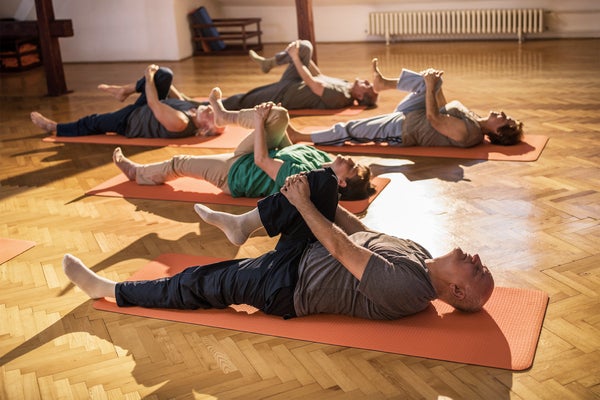These Exercises Can Help Protect Older Adults from Dangerous Falls
Tai Chi, yoga, water exercises and other low-impact workouts may help prevent severe falls among older adults

As people age, a simple slip can have devastating consequences. Falls are the leading cause of injury and death from injury among older people in the U.S., where more than a quarter of adults aged 65 and older report taking a tumble at least once in a given year.
A new study in JAMA Network Open estimates that at least 13 percent of people in this age group have endured a traumatic brain injury in roughly the last two decades, and falling is a leading cause. Even relatively healthy older adults, who aren’t already affected by underlying conditions such as cardiovascular disease or cognitive decline, aren’t spared from this somber statistic, says the study’s lead author Erica Kornblith, a clinical neuropsychologist at the University of California, San Francisco. Head injuries are generally more common among older adults because, for them, “injuries are likely to happen due to a fall in the course of everyday activities,” she says.
Fortunately, research points to lifestyle adjustments that can help. For example, it might seem that moving around more could increase the chances of a catastrophic slip, but a group of independent primary care experts on the U.S. Preventive Services Task Force recently recommended regular exercise as the simplest strategy to ward off future falls, especially if older adults start early.
On supporting science journalism
If you’re enjoying this article, consider supporting our award-winning journalism by subscribing. By purchasing a subscription you are helping to ensure the future of impactful stories about the discoveries and ideas shaping our world today.
Risk Factors
During the twilight years, the body inevitably weakens. Everyone’s muscle mass tends to decline with age, but people with a condition called sarcopenia experience more serious age-related muscle atrophy. Muscle loss whittles away at balance and gait and shortens the reaction time needed to catch ourselves if we stumble.
A slippery bathroom floor, a loose rug or other common obstacles can also pose tripping hazards for older adults who might already be unsteady on their feet. Poor lighting may hinder navigation among older adults with deteriorating vision and hence lower their spatial awareness.
Seniors are also more likely than younger people to have chronic health conditions that further increase the risk of falling. Diabetes and cardiovascular disease, for example, can contribute to a loss of sensory and motor function. Medications to treat these conditions as well as others may also inadvertently increase the chances of a tumble, says Kathleen Cameron, senior director of the nonprofit National Council on Aging’s Center for Healthy Aging. Waning kidney and liver function makes the body less efficient at metabolizing drugs. The resulting toxic buildup of such substances increases the risk of adverse effects such as lightheadedness, drowsiness and confusion; this can impair cognition and threaten navigational ability. “Balancing the risks and the benefits of those medications is really important,” Cameron says.
Fall injuries are often more severe in older adults because their body is simply more frail overall. Osteoporosis, a common age-related reduction in bone density, dramatically raises the likelihood of fractures. And hitting one’s head in a fall can cause brain bleeding—which can be even more dangerous if the person is taking anticoagulants, blood-thinning medications often prescribed to older adults, especially those with cardiovascular conditions. Healing after a fall also takes longer among older people, whose bodily systems may already be strained by other preexisting health difficulties.
Fall Prevention
This month the U.S. Preventive Services Task Force released new fall prevention recommendations for adults 65 years and older. Published in the journal JAMA, this report endorses regular exercise—especially training that engages the muscles used in daily activities—as a way to reduce one’s chances of falling.
Cameron and Kornblith recommend low-impact workouts, such as Tai Chi, yoga or water exercises, to help older adults build muscle tone—particularly if they need to work around orthopedic challenges.
It’s important to consult with a doctor before starting an exercise regimen, Kornblith says. A primary care doctor can screen for risk factors such as osteoporosis and can review prescriptions to check for possible overmedication or side effects that might compromise mobility.
People should also get a home safety assessment from a physical or occupational therapist to identify hazards. Cameron suggests outfitting a house with nonslip bath mats, raised toilet seats, grab bars and motion-sensing lights, among other appliances. “We need to change the home to meet the level of function that we have,” she says.
Some people may be resistant to such a lifestyle overhaul. According to the task force’s JAMA report, only two thirds of seniors adhere to intervention recommendations by a health care professional. Cameron says that older adults often resist medical advice for fear of being seen as too frail to live independently (and then being involuntarily moved into an assisted living home).
Older people who have experienced a fall often cut back on exercise altogether to prevent another such accident. But in many cases, avoiding physical activity only raises the risk of falls and injuries in the long run. Support from family and community can help address these fears. Supervised exercise with a physical therapist can improve safety and help prevent accidents. Moreover, experts recommend group exercises as they can additionally prevent depression and social isolation as well as establish communal ties.
Starting these interventions early is the best bet for preventing falls. Cameron even advocates for building an awareness of fall prevention in elementary schools so that children can begin embracing healthy lifestyles—and understand what’s at stake for their aging family members. “Let’s make it intergenerational,” she says. “Wouldn’t that be great?”
